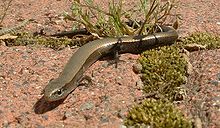Ablepharus kitaibelii
| Ablepharus kitaibelii | |
|---|---|

| |
| Scientific classification | |
| Kingdom: | Animalia |
| Phylum: | Chordata |
| Class: | Reptilia |
| Order: | Squamata |
| Family: | Scincidae |
| Genus: | Ablepharus |
| Species: | A. kitaibelii
|
| Binomial name | |
| Ablepharus kitaibelii (Bibron & Bory de Saint-Vincent, 1833)
| |
| Subspecies | |

| |
| Synonyms[2] | |
| |
Ablepharus kitaibelii, commonly known as the European copper skink, European snake-eyed skink, juniper skink, or snake-eyed skink, is a species of skink, a lizard in the family Scincidae. The species is endemic to Eastern Europe and Southwestern Asia.
Geographic range[]
A. kitaibelii is native to Greece (including the Aegean Islands), Romania, Bulgaria, the former Yugoslavia, Hungary, Albania, Slovakia, the Caucasus, Turkey, Syria, Israel, Jordan, Lebanon, the Sinai Peninsula of Egypt and possibly Iraq. The subspecies A. k. fitzingeri is known from Slovakia, Hungary, Greece and the island of Corfu. The subspecies A. k. stepaneki is known from Bulgaria and Romania. Also Macedonia
Description[]
A small, slender lizard, A. kitaibelii grows up to 15 cm (5.9 in) in total length (including tail). The skin is bronze-coloured, with dark sides. The eyelids are immovable, in contrast to many other skinks.
Habitat and behaviour[]
A. kitaibelii is a shy species, which lives under stones and leaves in dry places, such as south slopes, fields, and meadows. It is active during twilight, and hunts for insects and small snails. It is a typical ground dweller, and dislikes climbing.
Reproduction[]
Taxonomy[]
Many former subspecies of Ablepharus kitaibelii have been promoted to categorization as species, such as Ablepharus rueppellii and Ablepharus budaki.
Etymology[]
The specific name, kitaibelii, is in honor of Hungarian botanist Paul Kitaibel.[3]
References[]
- ^ Böhme W et al. (2009). "Ablepharus kitaibelii ". IUCN Red List of Threatened Species. Version 2013.1. Downloaded on 21 August 2013.
- ^ a b "Ablepharus kitaibelii ". The Reptile Database. www.reptile-database.org.
- ^ Beolens, Bo; Watkins, Michael; Grayson, Michael (2011). The Eponym Dictionary of Reptiles. Baltimore: Johns Hopkins University Press. xiii + 296 pp. ISBN 978-1-4214-0135-5. (Ablepharus kitaibelii, p. 142).
External links[]
- Species Ablepharus kitaibelii at The Reptile Database
Further reading[]
- Arnold EN, Burton JA (1978). A Field Guide to the Reptiles and Amphibians of Britain and Europe. (Illustrated by D.W. Ovenden). London: Collins. 271 pp. + Plates 1-40. ISBN 0-00-219318-3. (Ablepharus kitaibelii, pp. 178-179 + Plate 32 + Map 95).
- Bibron [G], Bory de Saint-Vincent [JB] (1833). "Vertébrés a sang froid. Reptiles ". pp. 57-76. In: Geoffroy Saint-Hilaire I, Geoffroy Saint-Hilaire É (1833). Expédition scientifique de Morée. Tome III.—1.re Partie. Zoologie. Paris and Strasbourg: F.G. Levrault. ("Ablepharis [sic] Kitaibelii ", new species, pp. 69-70). (in French).
- Duméril AMC, Bibron (1839). Erpétologie générale ou Histoire naturelle complète des Reptiles. Tome cinquième [Volume 5]. Paris: Roret. viii + 854 pp. (Ablepharus kitaibelii, pp. 809-811). (in French).
- IUCN Red List least concern species
- Ablepharus
- Lizards of Europe
- Lizards of Asia
- Reptiles described in 1833
- Taxa named by Gabriel Bibron
- Taxa named by Jean Baptiste Bory de Saint-Vincent
